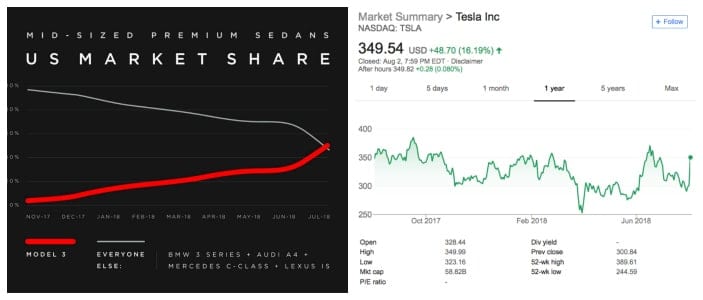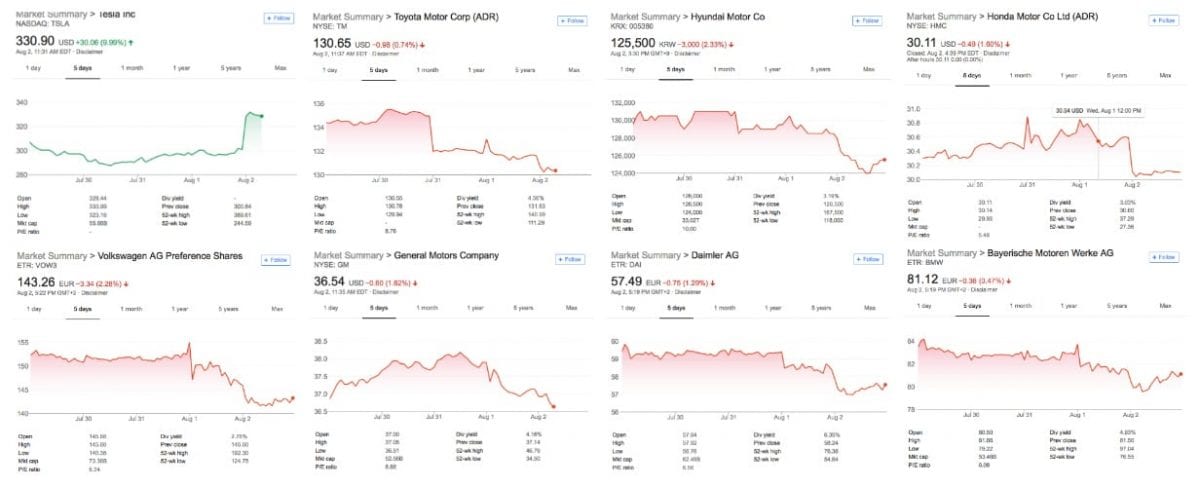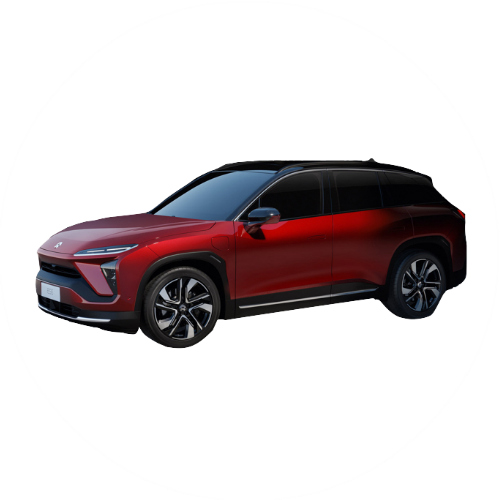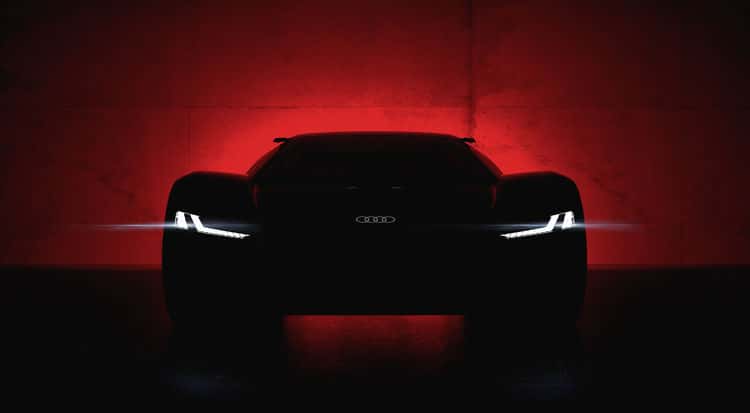TOP EV NEWS #1 – TESLA MAKES BIG AUTO SEE RED
The big news of the week for me is Tesla‘s announcement that it sold more cars than all its competitors together in the mid-sized premium sedan segment. Note I said “cars” and not “electric cars.” It is clear from the chart below left that Tesla has steadily been eating market-share away from big brands such as Audi, BMW, Mercedes and Lexus with an acceleration in June when Tesla emerged from its production hell with the Model 3. I feel sorry for those executives that claimed consumer demand for EVs is not there yet. In February 2017 the Alliance of Automobile Manufacturers asked President Trump’s newly appointed Environmental Protection Agency Tsar, Scott Pruitt, to withdraw the Obama era agreed on 54.5MPG emissions benchmark, required by 2025. The lobby group included big auto companies such as GM and Ford. The AAM’s reasoning is that achieving the standard is too costly and that the consumer demand is not there to support such a stringent rule. Really? At the time I argued that the consumer is being forced to accept combustion technology and should they have a choice they would obviously go for EVs. Well, now that the consumer has a choice the argument is made.
In Tesla’s Q2 earnings call this week Tesla listed the top five cars traded-in when consumers buy a Model 3. The cars are the Toyota Prius, the BMW 3 Series, the Honda Accord, the Honda Civic and the Nissan Leaf. It is interesting to see some cannibalization by Tesla on EV sales by taking sales from the Leaf. It is also encouraging to see how drivers of plug-in hybrid cars are getting over range anxiety and now converting to the pure electric Model 3 supported by Tesla’s growing network of fast chargers.

Tesla’s share price jumped 10% in after-hours trade on its Q2 earnings call and closed 16% higher the following day, lifting its market cap past GM’s, making it the most valuable auto company in the North Amerca. A lot has been written about the financial data in other reports so I will not dwell on it here. Looking at the prospects for the share price, the TSLA share came back and gave a classic goodbye kiss testing the breakaway in the flag formation I identified in Week 23. The next important resistance for TSLA is the tops in the $380 region after which it can go as high as $450.
For me, the most exciting result from the Tesla Q2 earnings call is the result it had on the share prices of its competitors. All of Tesla’s main competitors saw a significant downward reaction on the news that Tesla sold more than all of them combined. Earlier the week GM, Ford, and FCA reduced their full-year earnings forecasts by a combined total of $3 billion, which is now clearly the result of Tesla stealing their market share. Tesla, on the other hand, said that it will now show profits in its quarterly updates and start paying off debt. Looking at Tesla’s market grab the three companies can see a bigger hit to their earnings; maybe the Tesla shorts should rather focus on these opportunities!!
Elon Musk also gave some guidance on the company’s Gigafactory in China, saying that the company will not sell shares to fund the construction as it can raise funds from local banks through a loan. Furthermore, Elon said that they are confident that they can build the factory for a lot less than the $5 billion mentioned in the market. Tesla thinks that it can build a 250,000 unit factory for $2 billion.

It was also announced that Autopilot V9 would roll out in four weeks. It is rumored the new upgrade can push Tesla’s autonomy level from Level 2 to Level 3, stealing the thunder from Audi which claimed the A8 is the first Level 3 car. (Audi’s claim is misleading as the function is only available at speeds below 37mph and only available in models in Europe sometime next year and undefined for the USA.) Tesla also stunned the market dropping a bombshell announcement during the call related to its AI computer which would be in its cars soon. Currently, Tesla uses a Nvidia chip, but its new AI chip will be more powerful by order of magnitude handling more than 2,000 frames per second of video, ten times faster than current tech. Tesla’s AI chip does this by bypassing the GPU or CPU running computations in the silicon itself.
Earlier the week it was reported that Tesla plans to give the Model S and Model X a full interior upgrade in Q3 2019. Although this surprised some buyers who hoped that updates would have happened this year, I suspect this has to do with the autonomous capabilities of the cars. Did Elon not tweet earlier that the Model Y might not even have a steering wheel?
In related news to the opening paragraph, Donald Trump on a whim decided to freeze fuel efficiency requirements set by the EPA through to 2026. It will be interesting to see how the freeze will affect EV adoption in the USA and if the country will fall further behind China and Europe. The decision by Trump is being challenged by a coalition of attorneys general led by Massachusetts Attorney General Maura Healey who is suing the federal government to keep the emission guidelines in place, citing health issues, environmental degradation and the financial impact of climate change.
TOP EV NEWS #2 – HYDROGEN SHORTAGE IN CALIFORNIA
Toyota revealed the second iteration of its Class 8 Fuel Cell Electric Truck at the Center for Automotive Research (CAR) Management Briefing Seminar. The truck named “Beta” is the second vehicle from the Japanese automakers Project Portal started in April 2017. “Beta” offers an increased the range of the first vehicle “Alpha” by 100 miles bringing it to 300 miles per fill. To date “Alpha” has completed 10,000 testing miles in real-world conditions driving around the Ports of Long Beach and Los Angeles. “Beta” has the same specs as “Alpha”, providing 670-plus horsepower and 1,325 pound-feet of torque from two Mirai fuel cell stacks and a 12kWh battery.
The announcement came at the same time as a hydrogen shortage in California resulting in dealers offering to compensate Toyota Mirai owners for rental vehicles. Twitter user @ferio_252 tweeted a sign at one of the 33 hydrogen fueling stations built by Toyota, Hyundai, and Honda. The shortage is due to supply constraints at chemical provider Air Products.
The sign read “Be advised: Hydrogen delivery issues everywhere. Don’t take chances, top off frequently. Toyota hotline says dealers know, will comp you for rental car.”
Toyota is still doubling down on Fuel Cell technology, leaving it exposed to bat for the technology with infrastructure investment. Toyota is not the only companies with a biased to FCEVs and in the 2017 KPMG Global Automotive Executive Survey, an overwhelming number of executives still saw Battery Electric Vehicles fail and Fuel Cells to be the real deal. The sudden increase in popularity of battery electric vehicles is forcing a rethink. Pushing for FCEV adoption is not without its challenges. Hydrogen fuel-stations cost upwards of a one million dollars to build while a charging station around $5,000, making it far easier to create a BEV charging network. A further challenge with hydrogen is that it is highly combustible creating a risk to transporters and drivers in extreme situations. What would you rather drive? A dirty ICE vehicle with a fire hazard, a clean EV with a fire hazard or a clean FCEV with an explosive hazard?

TOP EV NEWS #3 – CHINA DOUBLES DOWN ON EV ADOPTION
The Chinese Ministry of Finance announced this week that New Energy Vehicles (NEVs) would be exempt from Vehicle and Vessel tax. The changes also make provision that the same tax on hybrid vehicles would be halved, this is vehicles using less than 1.6L/100km. There is a caveat though, only vehicles from producers that comply with quality, range and efficiency standards, safety and battery recycling requirements will qualify.
In Week 16/18 I reported that the Chinese Government was considering to use the resort island of Hainan as a test case to ban fossil-fuel vehicles. This week the Chinese Ministry of Industry and Information Technology (MIIT) and the Hainan Provincial Government signed a strategic co-operation agreement that starts the process to ban ICE vehicles on the island by 2030. Hainan had 15,000 EVs and 2,900 charging points by the end of 2017 which it plans to increase tenfold by 2020. The Hainan Government’s EV mobility strategy will include changing its bus fleet to 80% EV by 2019, requiring ride-hailing companies to use EVs and promote bike sharing and time-leasing of cars.
TOP EV NEWS #4 – NEW CARS
The cover of this weeks newsletter shows the teaser image released by Audi of its first electric supercar concept, the Audi PB18 e-tron, named after the event where it will be revealed on the 23rd of August 2018. This year’s Pebble Beach Car Week in Monterey, California will be the host of the PB18 which follows on the technology of the Audi R18 e-tron the LeMans-series winner.
Chinese EV start-up Yudo launched improved versions of the Yudo π1 and π3 called Yudo π1 Pro, Yudo π1 360 and Yudo π3 Pro. You can now buy a Yudo with a range of 251 miles (402km) for as little as $13,000 after subsidy. For the full specs follow the link here.
Spy images of the NIO ES6 EV SUV emerged on the internet this week. NIO announced the release of the ES6 at a press briefing in May 2018. At the time the company stated that the ES6 will be the first EV from its production line in Nanjing. To date, the ES8 is produced at NIOs contract manufacturing partner JAC in Heifei.

TOP EV NEWS #5 – NEW BRANDS AND STRATEGY UPDATES
In a bid to revitalize the struggling state-owned Hongqi, FAWs luxury brand known for producing limousines for the Chinese state this week unveiled its new EV strategy. Hongqi will develop two platforms, the “532” for larger vehicles and the “432” for smaller vehicles. Hongqi Auto will build five pure electric vehicles, three plug-in hybrids, and two combustion vehicles on the large platform and four EVs, three PHEVs and two ICE vehicles on the smaller platform.
Dearcc launched its luxury brand in Beijing on the 31st of July 2018. The brand named ENOVATE is expected to unveil its first EV, an SUV in October 2018. For the full insight into the brand’s plans, production and management follow the link here.

AUTONOMOUS VEHICLE NEWS OF THE WEEK
Four Chinese companies this week entered into a JV to mass produce a clever truck by 2020. The companies forming the joint venture is JD Logistics, WM Motor, Global Logistic Properties (GLP), and JUMA. The trucks AI platform will improve safety and efficiency and is managed by JUMA’s logistics SaaS asset management platform operated. WM Motors will provide the EV development and manufacturing while JD Logistics will provide its R&D for the AI platform.
The Chinese capital of Zhejiang province, Hangzhou, this week approved the testing of Autonomous vehicles on its roads. Hangzhou is home to many of China’s auto companies and EV start-ups such as Dearcc, Karma, LeEco, WM Motors and Geely. The new regulations will come into effect on the 20th of August. The regulations include a panel to evaluate test applications, examine tested vehicles and issue the road testing number plates. The regulations also set strict requirements on drivers of the test vehicles such as requiring them to have at least 50-hours experience in operating of autonomous test vehicles. Hangzhou joins other Chinese cities such as Beijing and Shanghai allowing testing of self-driving vehicles on public roads.
China’s Google, Baidu, announced that its Q2 revenues jumped 32% contributing resulting in a jump in net profits by 31%. Robin Li, Baidu’s CEO, highlighted its self-driving program Apollo’s contribution to the successful quarter. Apollo has signed 119 OEMs and parts suppliers including Daimler and BMW to its open source platform. We reported in Week 27 that Apollo started producing its first Level 4 autonomous vehicle the Apolong transporter.
In May Baidu, Lifan and EV rental company Pand-Auto started testing China’s first shared self-driving pilot program in the municipal area of Chongqing.


